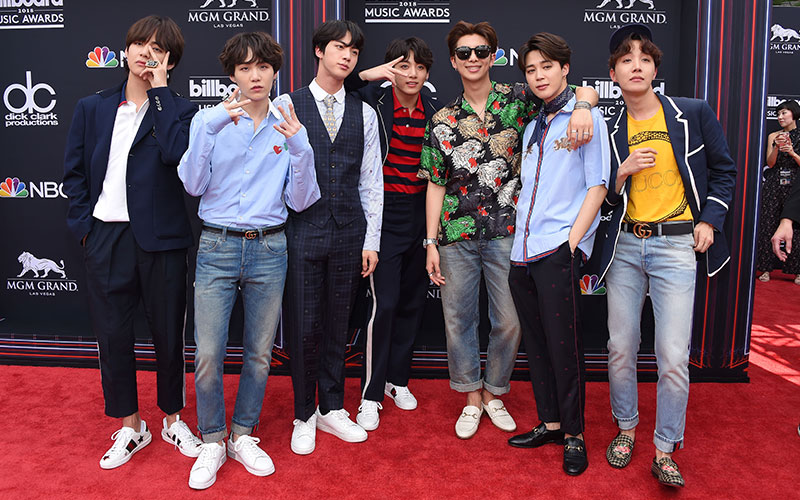Anakin Sirikit, themomentum.co [translation]
- South Korea has come to this day. Not only because of its rich cultural assets. But because of the strategy and the development of the capacity of the relevant organizations.
- South Korea pays attention to 'Public Diplomacy' as the second national achievement tool, followed by North Korea's nuclear problem and permanent peace on the Korean Peninsula.
- However, Korean flows are limited. How can this power flow to Korea? Will this power have an expiration date? How do we make this wave of our culture last?
The success of BTS in the world is also the cultural and foreign success of South Korea as well. This article invites readers to understand South Korea's thinking in extending cultural and foreign influence through ideas. "Public Diplomacy", which points out that South Korea has come to this day. Not only because of its rich cultural assets. But because of the strategy and the development of the capacity of the organization involved.

What is a public diplomat?
In the academic diplomacy. There are many scholars who define this term. The definition I see most is the definition of Bruce Gregory. He says that public diplomacy is "Tools of the state Related organizations of the state And non-state actors To understand culture, attitude and behavior, create and manage relationships. It also influences thought and action, expands the benefits, and sets the value of those actors. "
South Korea attaches great importance to public diplomacy as a second-tier national instrument, second only to the solution to North Korea's nuclear problem and to permanent peace on the Korean Peninsula. The South Korean Ministry of Foreign Affairs website says the government will use public diplomacy coupled with a people-centered diplomacy.This concept is consistent with the translation of the Korean Public Diplomacy or 공공 외교, which translates as "People-Centered Diplomacy." Diplomacy by the people and for the people. People in this area also include foreigners and Koreans.
Cultural Development Plan
Before the Korean Wave became a major resource in expanding cultural and foreign influence.South Korea has seen another way of forming cooperation in the past, with the founding of the Korea International Cooperation Agency (KOICA), which promotes international development projects.And the Korea Foundation (KF) in 1991, focusing on academic and research activities. In particular, the promotion of knowledge development and networking of Korean studies in the world and the region. The two organizations conduct a variety of continuous activities.
Strategic efforts and capacity development of these organizations have only been substantive in the presidency of Emperor-Buck. In 2010, the Ministry of Foreign Affairs approved the establishment of the National Brand Board. "Cultural Diplomacy Manual (문화 외교 메뉴얼)" for the first time.
In the days of the government, And encourages the Council to pass a resolution approving the draft.The "Public Diplomacy Act" (2016), which focuses on the implementation of concrete and consistent policies in all sectors. By establishing a national diplomatic board. That led to certification. The promotion of awareness and understanding of North Korea and the issue of peninsular issues. CountryPromoting integration between central organizations and local organizations. Promote public diplomacy that directly affects policy implementation.
3 types of diplomatic missions: cultural diplomacy. Diplomacy focuses on knowledge. And policy diplomacy. It is the South Korean plan. "Communicate with the world with charming Korea. Together with the Korean people "
Even in the overall picture of these strategies, they look pretty good. The first is a public diplomacy activity involving education and culture, such as scholarships. Cultural exhibitions, youth exchange programs. Often a project with a lot of investment. But the return is not clear. Or did not see immediately. Or is it more qualitative than quantitative? The project is the budget. Project managers also have the task of defending and explaining the reasons to the relevant government agencies and the legislature.
The second is Politics of Ideology and Public Diplomacy Policy Especially from the conflict between conservative and progressive parties in Korea. I call it The two Koreas will have different agenda or issues, such as embroideries, which will focus on promoting the self-reliant development of the New Village Movement / 새마을 운동. My father's inheritance policy. The government is currently a progressive government. It will cut the budget to support this project. Not to mention very much It also focuses on public diplomacy programs such as promoting films related to the massacre of Kwangju, Taxi Driver, etc.
The third is Jeffrey Robertson, an expert on public diplomacy from Australia, conducted research, diplomatic missions and corporate governance at the Ministry of Foreign Affairs, pointing out that Although Korea is leading the way in digital technology. Public relations and public diplomacy activities in the digital space are extremely limited. Most of the content is in Korean. It was also analyzed that the ministry was more focused on communicating with the people in the country. Meanwhile, the new generation of diplomats were not encouraged to use their own social media to disseminate or promote the ministry's mission.
The last and most important is. Promote the active role of the public as a diplomat. President Mundi is very important. Many of you may never know. A new generation of Koreans around the age of 20-30 years have called their country "Hell Joseon". His country has no future, it is difficult to compete, it is high. The Public Diplomatic Academic Conference offers opinions on this issue. This group of people will become critics and resist the policy that we do to foreigners, so they must find opportunities to invite them to participate in most activities.
Korean Culture Wave ... Advantages and Limitations
I have the opportunity to contribute articles and research on the Korea's Public Diplomacy Program , sponsored by the Ministry of Foreign Affairs of South Korea. We found that the main theme that foreigners perceive most about South Korea is: The Korean Wave (K-Wave / 한류) in the form of consumer goods, restaurants, television dramas, etc. This flow affects the perception of the Thai people on the social condition. everyday life Characteristics of Koreans.Has attracted more tourists to South Korea.
However, the Korean Wave has its first limitation, namely, the sustainability of the Korean Wave.
In the seminar of the research project, we asked how Korean power can be achieved. Will this power have an expiration date? How do we make this wave of our culture last? The second is Limitations in contextual communication. Korea does not have a positive response in every region. Southeast Asia is the largest market. The Korean Wave has just started to be popular in Europe and America. From the popularity of BTS
The most interesting part is. Perspectives on Korean culture in close neighbors like China and Japan. One article in the project. Points out that The activities of anti-Korean wave appeared in two countries with different reasons. Korea's resistance to the Korean government is a major player. The reason for the economic and political situation is because the Korean Wave has a dominant market share in the Chinese media. Coupled with interactive efforts, decision to install missile range or THAAD.
As in the case of Japan Anti-Korean wave is a reaction against the Japanese in South Korea. There is a group of Japanese people who want to confirm the greatness of the nationalist-military concept as the head of the movement. And try to reduce the value of the wave of Korean culture in ways such as holding a banner labeled "No More Zombie Wave" etc.
In general, as a recipient of KF scholarship, which is a product of the country's diplomatic policy, I think there are some issues that could potentially benefit Thailand's diplomatic mission, both Thai and Korean. A rich cultural asset. The team has tried to bring the pantomime show. Encourage Thai entrepreneurs to exhibit overseas products. Thai tourism promotion, etc., which is well done.
The Korean lesson is important in this regard. To do continuously and seriously. It is important to evaluate long-term outcomes and activities. I do not know what to do tomorrow.
Tags: Public Diplomacy, Cultural Diplomacy 
No comments:
Post a Comment